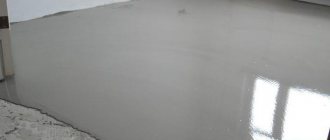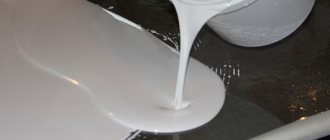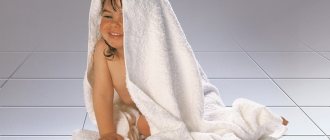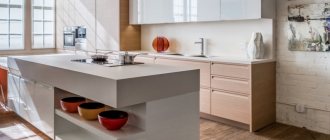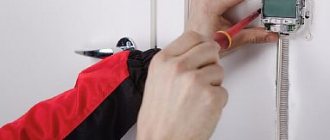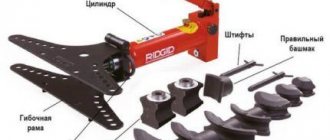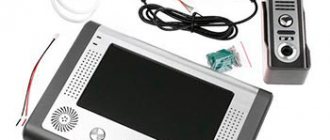An easy-to-install gypsum or cement-polymer self-leveling floor will allow you to independently level the surface of the concrete screed with optimal expenditure of working time and money. The technology is based on the use of environmentally impeccable self-leveling dry construction mixtures, characterized by ease of preparation, strength, hardening time and service life. But which self-leveling floor is better for a country house: gypsum or cement?
Is it possible to lay tiles on a gypsum self-leveling floor?
You can lay tiles only after the self-leveling floor has completely dried. The drying speed of the self-leveling floor depends on the base material. There is a cement, gypsum or cement-gypsum base. ... Advice: do not forget to apply primer to the dried self-leveling floor to strengthen the adhesion of the self-leveling floor and tile adhesive.
Interesting materials:
How to erase paste in a notebook? How to erase a pencil from wood? How to erase a pen without leaving marks? How to erase a pen from a diary? How to erase a pen from gel polish? How to erase pen from glossy paper? How to remove a handle from a leather backpack? How to remove a handle from a leather chair? How to remove a handle from the leather of a sofa? How to erase a pen from non-woven wallpaper?
Let's sum it up!
Gypsum composition
- quite durable, but fragile material that produces dust.
For an inexpensive floor used in a dry room, the thickness of the fill can be within 30 mm. When choosing, take into account poor adhesion to cement-based tile adhesives. These disadvantages of gypsum casting are partially compensated by its relatively rapid hardening.
Cement-polymer
self-leveling floor is a more expensive material, characterized by excellent strength, ideal self-leveling properties, and a smooth, wear-resistant coating surface.
The composition is not picky about preparing the base, so it saves time and money by eliminating multi-layer priming.
Self-leveling floors can be used without problems in rooms with high humidity.
How to pour a gypsum or cement floor yourself?
- Before applying the solution, the working surface must be cleaned of dust and primed. Coatings with a thickness of 10 mm or more require the use of damper tape.
- For thick screeds in the bathroom or kitchen, it is advisable to install additional waterproofing. The Yunis product line of dry building mixtures together allows you to perform work on leveling and waterproofing the floor at any stage of the process. In the absence of proper experience, it is better to control the uniformity of pouring by installing beacons.
- The quality of the casting solution is largely determined by the homogeneity of its structure. And this can only be achieved by mechanized mixing using a concrete mixer or construction mixer.
- The resulting composition is poured in any convenient way and smoothed with a spatula. To remove air, it is treated with a needle roller. The prepared filling composition must be used before it begins to harden. It is impossible to restore its functionality by adding water and stirring.
Calculation of the number of components for concrete
To calculate the required number of components, it is necessary to calculate the total volume of the mixture. To do this: multiply the average height of the screed by the length and width of the room.
If the floor width is 3 m, length is 4 m, the lower point of the screed is 3 cm, the upper point is 4 cm, the average height of the screed is (3+4) / 2 = 3.5 cm, the required volume is 0.035 m * 3 m (width) * 4 m (length) = 0.42 m3.
Marking the floor for screed
To prepare a mortar with a cement to sand ratio of 1:3, you need to take 0.105 m3 of cement and 0.315 sand. 1 m3 of cement has a mass of approximately 1500 kg, then its required amount is 0.105 * 1500 = 157.5 kg. 1m3 of sand is 1400 kg, then its required amount is 0.315*1400=441 kg.
A little about the types of self-leveling compounds
The technology for working with self-leveling floors is simple. The composition is sold in ready-to-use form; it is enough to dilute it with water to the consistency recommended by the manufacturer. After thorough mixing, the semi-liquid mixture is poured onto the floor, stretched with a squeegee and passed with a needle roller to remove the smallest air bubbles. All that remains is to wait for the composition to harden.
Mixtures showing different characteristics designed to solve specific problems can be purchased on the market. For example:
- polyurethane mixtures consist of a polymer, a hardener and special additives, are characterized by high fluidity, and can be used with acrylic dyes. Designed to create a finishing coating;
- compositions based on epoxy group resins also contain a main substance, a hardener and additives. After drying, this floor forms a durable glassy surface that is resistant to aggressive chemicals. A separate group of compounds forms a transparent layer, therefore it is used for artistic floors, including 3D floors;
- Methyl methacrylate mixtures are characterized by the highest setting speed; as a finishing coating of small thickness, they work as a means of strengthening the surface, giving it chemical resistance. The composition is absorbed into concrete, forming a strong and wear-resistant material.
Other groups of compositions contain polymer and cement. They differ in complex characteristics, depending on the components they contain. But all of the listed self-leveling floors are quite expensive and using them for rough or preliminary leveling is ineffective.
Floor temperature
Concrete itself is a fairly cold material. Therefore, many buyers are afraid that both 3D and self-leveling floors will not be warm. Owner reviews see pros and cons in both types. Some argue that the new floor is warm in winter and summer. Others advise installing a heating system under the screed. But not everyone liked this idea. They say that at high temperatures harmful substances will begin to be released. Reviews from experts say that the polymer is a very durable material that does not allow any substances to pass through when heated.
Consumers who need a flat surface for laying linoleum or other coverings use gypsum self-leveling flooring.
Selection of finishing compositions
Of the huge range of flooring compositions, it is worth noting the most popular:
“Prospectors Quick-hardening” (from 270 rubles) based on gypsum. Most often used in living quarters, kitchens and hallways. A mobile solution, within forty minutes you can have time to pour it over a fairly large surface. A fairly well-known mixture that is used even by experienced specialists.
“Prospectors Tolstoy” (from 230 rubles) based on cement. Levels concrete floors with very strong unevenness. Used for applying thick layers. They come out heavy, but at the same time durable. Suitable for garage and bathroom, as well as outdoors with some kind of canopy. It takes the longest to dry on this list.
Brand Unis. “Horizon Universal” (from 270 rubles). Suitable even for wet rooms, on any basis. The name speaks for itself - the mixture is universal, it can be used under tiles in a toilet or bathroom.
Bergauf Easy Boden (from 340 rubles). It can be poured both in living quarters and in the bathroom and toilet. Also suitable for creating “warm floors” and for any fine finishing.
“Knauf-Tribon” (from 320 rubles). Suitable for all types of premises, including toilet floods. You can walk on the surface after 6 hours, and a day later you can put up furniture and continue repairs.
You need to be careful when choosing mixtures for self-leveling floors. Consider all factors: type of room, temperature, humidity, further finishing option, and so on. Do not forget to read the composition of the mixture, it can indicate the quality of the product, and during the process of pouring the floor, carefully follow the technology. Only in this case will you be able to make a self-leveling floor at home.
To learn how to choose a cement-based self-leveling floor, see the following video.
Floor coating with liquid glass
Among other things, liquid glass is often used to fill the floor. After installation, such a self-leveling floor creates a smooth and glossy surface that is very reminiscent of real glass, only in liquid form. It is often found in medical institutions because it is easy to clean and does not absorb bacteria. In fact, liquid glass is always glossy and transparent, but it is possible to paint it in order to achieve a different shade. In these cases, special dyes are used that are added to the mixture.
You can also create a 3D effect. To do this, you need to put a printed drawing or other three-dimensional objects of your choice and color between the layers.
The advantages of such floors:
- Smooth surface.
- Does not burn.
- Does not react to chemicals.
- Vibration resistant.
Types of self-leveling floor screeds
The self-leveling mixture will, of course, make it easier for you to screed the floor, but you shouldn’t expect any miracles from it. You can simply pour the screed and wait for the result only if there are only small irregularities on the floor surface. In other cases, you may have to use several types of self-leveling screeds.
There are several types of self-leveling compounds, which should be selected taking into account the room where they will be used
Types of self-leveling compounds:
- A rough self-leveling screed is used when the floor is in critical condition. This composition is poured into a fairly thick layer (about 5-7 cm).
- The medicinal mixture is used to eliminate defects in certain parts of the floor. This product will perfectly cover small holes and cracks.
- The finishing liquid leveling mixture is used for the final preparation of the floor for installation of decorative covering. This composition is applied in a layer of 0.2-1 cm. After the finishing screed dries, you will receive a perfectly flat and smooth floor.
Each type of screed is used in its own specific case. Sometimes it happens that you have to combine several layers of different products on one floor. Often, rough and finishing screeds are used together. A combination such as a local and finishing mixture is also possible.
Self-leveling mixture can be used on almost any substrate. The only exception is wooden floors. However, some craftsmen claim that a strong wooden base can be leveled with a finishing compound if you first put a film under it.
This is interesting: Linoleum on a concrete floor: we explain it step by step
Expert advice
Typically, one bag of mixture is designed for one batch, but everything will depend on the quality of the floor surface and the presence of curved areas on it.
Taking into account water, when mixing from one bag, 20 liters of solution are obtained; it is not recommended to do more at one time. Since the solution is liquid, there are no joints when pouring it; one room is filled at a time, by carrying out several pours. To remove air efficiently, the roller with needles should be several millimeters above the pouring level.
To prevent the mixture from spilling outside the room, you need to install dampers; it is better to do this right away than to install them in a hurry.
Advantages and disadvantages
Let’s say right away that we cannot say that cement floors are better than gypsum floors and vice versa, it all depends on the specific situation. In one case, gypsum “works” better, in another, cement, so there can be no pure “pros” or “cons”. Let's put the general properties in the table:
| Indicators | Cement floors | Gypsum floors |
| Strength | Strength is higher than gypsum | Strength is lower than that of cement |
| Drying | Dries and hardens longer than plaster | Dries and hardens faster than cement |
| Moisture resistance | High moisture resistance | Medium and low moisture resistance |
| Frost resistance | High frost resistance | Virtually absent |
| Spreadability | Spreadability is worse than gypsum | Flowability is better than cement |
| Surface quality | The surface quality is worse than that of gypsum | Surface quality is better than cement |
| Layer thickness | Narrow application thickness range | Wide range of application thicknesses, can be used as a thick layer screed |
| Environmental friendliness | Environmental friendliness is lower than that of gypsum | More environmentally friendly than cement |
| Warm floor | Used for heated floors | Used for heated floors |
| Price | The price, as a rule, is significantly higher than gypsum | The price, as a rule, is significantly lower than cement |
Now that we are familiar with the general properties, let us describe the selection algorithm:
- Warm or cold room? (cold - cement; warm - cement or gypsum)
- High humidity or moderate to low? (high - cement; low - cement or gypsum)
- Are high loads expected or not? (high - cement; low - cement or gypsum)
In principle, having answered these questions, you can already make a choice. For example, if it is a balcony, basement or unheated garage, then only a cement floor is definitely suitable, because... It's cold and damp here. If this is an office or a sales area, despite the fact that it is not cold or damp there (we hope), then you still need to use cement, because... it has higher strength, just suitable for high loads.
If this is a room in an apartment or a kitchen, then it is better to use gypsum, because: it is more environmentally friendly, there is practically no load, it levels and dries better and faster, and the price is lower. It is possible to use a cement floor in an apartment, but it does not make any sense, except, perhaps, for the bathroom and toilets. There is no need to worry that the gypsum floor will fall apart under your weight or furniture, it will not fall apart. The average strength of such floors is 15 – 20 MPa, which, excuse me, is 1500 – 2000 kgf/m2 – that’s a lot :)
We really hope that at least as little as we could, we helped to understand this issue and eased the “pangs of choice.” If you have (or have) any questions, additions or comments, please write to us by email or call, we will be happy to help.
Might be interesting:
- Self-leveling floor or screed – which is better to choose?
In our online store you can always get advice from an experienced specialist on the product you are interested in, its application and find out its properties and technical characteristics. After you have chosen a product and you are satisfied with the price and conditions, you can place an order in just a few minutes, delivery with unloading and lifting to the floor in Moscow, the Moscow region (in some cases throughout Russia) or buy the selected material for pickup from warehouse or factory. We work with both legal entities and individuals. We organize fast delivery to cities such as Moscow, Balashikha, Podolsk, Khimki, Korolev, Mytishchi, Lyubertsy, Krasnogorsk, Elektrostal, Kolomna, Odintsovo, Domodedovo, Serpukhov, Shchelkovo, Orekhovo-Zuevo, Ramenskoye, Dolgoprudny, Pushkino, Reutov, Sergiev Posad , Voskresensk, Lobnya, Ivanteevka, Dubna, Yegoryevsk, Chekhov, Dmitrov, Vidnoye, Stupino, Pavlovsky Posad, Naro-Fominsk, Fryazino, Lytkarino, Dzerzhinsky, Solnechnogorsk, Istra and Zhukovsky. Contact us, we will be glad to see you!
3d floors
A very impressive interior element is a self-leveling polymer 3D floor. It differs from the usual one by its stereoscopic effect.
Such floors are often placed in the halls of various cultural and entertainment institutions. More and more often they can be seen in apartments, not only in large ones, but also in small ones. The advantage of a floor with a three-dimensional image is its original appearance. You can order or make any drawing yourself. Before pouring the polymer, various decorations, such as shells and stones, are placed on the floor.
3D floors have a wide variety of themes. These can be flowers, animals, bodies of water. Sometimes they combine patterns on walls, curtains and other interior elements. Owners often place images of fish and dolphins in their bathrooms. Sometimes, however, these drawings seem inappropriate from the outside. Thus, images of monsters from films can hardly be considered an acceptable solution. And the abyss in the middle of the room will tickle the nerves of the guests and the owner himself for a long time.
How are these self-leveling floors created? Reviews from owners of such original coatings indicate that they can be made with your own hands.
What does self-leveling mean?
Why is it needed?
The floor, as you know, must be smooth and durable. A few decades ago, this was ensured by the use of cement-sand screed.
But progress does not stand still, and science has given us such a miracle as a self-leveling self-leveling floor. With its help, you can quickly and efficiently level the surface, and put it into operation in a short time.
The question of which is better: self-leveling floor or screed is somewhat incorrect. Because if you look at it in detail, self-leveling flooring is one of the types of screed. Only it is produced on a different basis and filled using slightly different technologies.
Why such a coating is necessary can be answered in a nutshell, for ideal, quick leveling of the floor. Moreover, this technology allows even an untrained person to do this work with his own hands, if he has detailed instructions.
Types of coating
For different types of premises, different self-leveling floors are used, in particular, it is customary to distinguish.
- Self-leveling coating based on cement.
- Self-leveling coating based on gypsum.
- Self-leveling coating made from synthetic polymers.
The first 2 types are more used for residential premises, as an ideal intermediate layer for laying the finishing coating. The third type is more often used for filling large industrial premises. It has also found its application in the arrangement of decorative, designer floors.
Self-leveling floor scheme
Mixtures used for flooring
Self-leveling mixtures are usually used exclusively at the final stages to create a perfectly flat floor. They are used when the height difference is no more than 40 mm. Theoretically, it is possible, by pouring layers, to even out large differences, but the price of such mixtures is quite high and such a screed will be very expensive.
Therefore, we advise you that if your floor has too large differences in plane and horizon, first fill the beacons using a reinforcing mesh with a regular cement-sand mixture, and then, when it dries, this is up to 1 month, level special solutions.
A self-leveling cement floor is a mixture of the main component, which is cement with the addition of polymer-based modifiers.
A distinctive feature of this mixture is that it is not afraid of high humidity and can be used in damp rooms.
- The coating also has a high compressive or bending strength.
- The coating, due to the presence of cement, adheres perfectly to concrete.
- Has a high degree of wear resistance.
Gypsum self-leveling flooring is a similar mixture, but uses gypsum as a base.
This coating is no longer as durable as cement.
- It cannot be used in damp areas.
- Its flexural and compressive strength is much lower.
- The coating, although quite strong, is fragile.
- It is not recommended to lay ceramic tiles on it.
- Among the advantages are the short drying time and the price is more affordable.
Scheme of decorative self-leveling coating.
Advantages
- Durability. The self-leveling floor will serve for at least 20 years. The mixture adheres well to concrete, which allows you to obtain a high-quality coating.
- Tightness. It has no seams, so there is nowhere for dirt to accumulate.
- Has a small thickness. Highly filled up to 4 cm thick, thin layer even smaller.
- Absolutely flat surface. The liquid composition is leveled under the laws of physics. If the floor is thick, markers are used to obtain a flat surface.
- Not slippery.
- Lasting.
- It does not sag, so the furniture does not leave marks on it from the legs.
- Does not burn.
- Does not form dust on its surface.
- Doesn't rot.
- Does not harm health.
Test to check the moisture content of the screed
It is during this period that the cement self-leveling floor gains full strength and reduces humidity to standard levels. However, drying time may be reduced at certain temperatures. Therefore, there are tests that can be carried out to check the moisture content of the screed. Works on gypsum and cement self-leveling floors.
Test 1. Scientific
There are devices that will determine surface humidity.
Test 2. Practical
For a day, secure a piece of polyethylene measuring one meter by one meter to a screed. If moisture appears on the film after a day, the solution has not yet dried.
Test 3. Quick
Take a metal bowl and fill it with hot water. Place the basin on the screed. If, after a few minutes, a dark spot appears on the surface of the screed, it means that the screed has not yet dried.
How to calculate material consumption
When determining the optimal layer thickness, the following factors must be taken into account:
- Mechanical, shock and abrasion load. The higher it is, the thicker the coating should be and the stronger the material. Manufacturers indicate the recommended load limit on the packaging.
- Condition of the base. If there are many defects, they are deep and extensive, more solution will be required to level them.
- Maximum permissible floor weight. Self-leveling floors are quite heavy. The weight of 1 square meter of coating with a thickness of 1 mm is 1.4-1.8 kg, which creates additional load on the supporting structures.
To find the material consumption, you need to know the mark of the rough (finish) floor. To do this, determine the highest possible point of the base, and then, taking into account the required thickness of the layer on the walls, use a level to beat off the required height. The depth of the largest irregularities is also measured and added to the resulting thickness. Now it is enough to multiply the area of the room by the required layer height. For several rooms, the task is complicated by the fact that the floor level must be the same everywhere.
After the volume of the floor in finished form has been found, you need to recalculate it for the dry mixture in bags. With a liquid screed thickness of 10 mm per 1 sq.m of floor, approximately 17-18 kg of dry mixture will be required. Based on this proportion, you can determine the consumption of products for each room.
For convenience, the calculation results are presented in table form.
You need to include some margin in the calculation. Quick-hardening mixtures are viable within 40 minutes, so it is recommended to pour floors continuously. And if there is a shortage of material, it will be difficult to correct this mistake.
Scratch resistance
Self-leveling 3D floors cause different opinions and assessments. Reviews from owners indicate that many have scratches on the floor. Although modern technologies make it possible to cope with this problem.
Consumers are advised to choose a light-colored floor. It shows less scratches. Or choose a self-leveling floor that does not leave scratches. Moreover, it does not fade and does not need to be polished.
But bumps may also appear. This happens when the surface under the self-leveling floor is not of sufficient quality.
User reviews say that decorative floors go well with the interior.
They are easy to clean. Five minutes is enough to wipe off the dust. Dirt is not absorbed into such a floor.
Reviews from other consumers note that self-leveling decorative flooring attracts dust and is very noticeable. Therefore, you have to clean it often and thoroughly.
Flaws
But not everyone likes self-leveling floors. Owner reviews see the disadvantages in the fact that they:
- Easily scratched and faded.
- It takes a long time to harden, about 6 days.
- Difficult to care for. To ensure that the quality does not deteriorate, the floor is washed with special products using a washing machine.
Experts who install such floors claim that it is environmentally friendly. Consumers did not detect the presence of harmful substances that could cause an unpleasant odor.
What else needs to be considered is the color of the image. It's not enough to just watch it on your computer. It is necessary to print a test copy, as often the colors in the image do not correspond to the actual tone of the floor.
